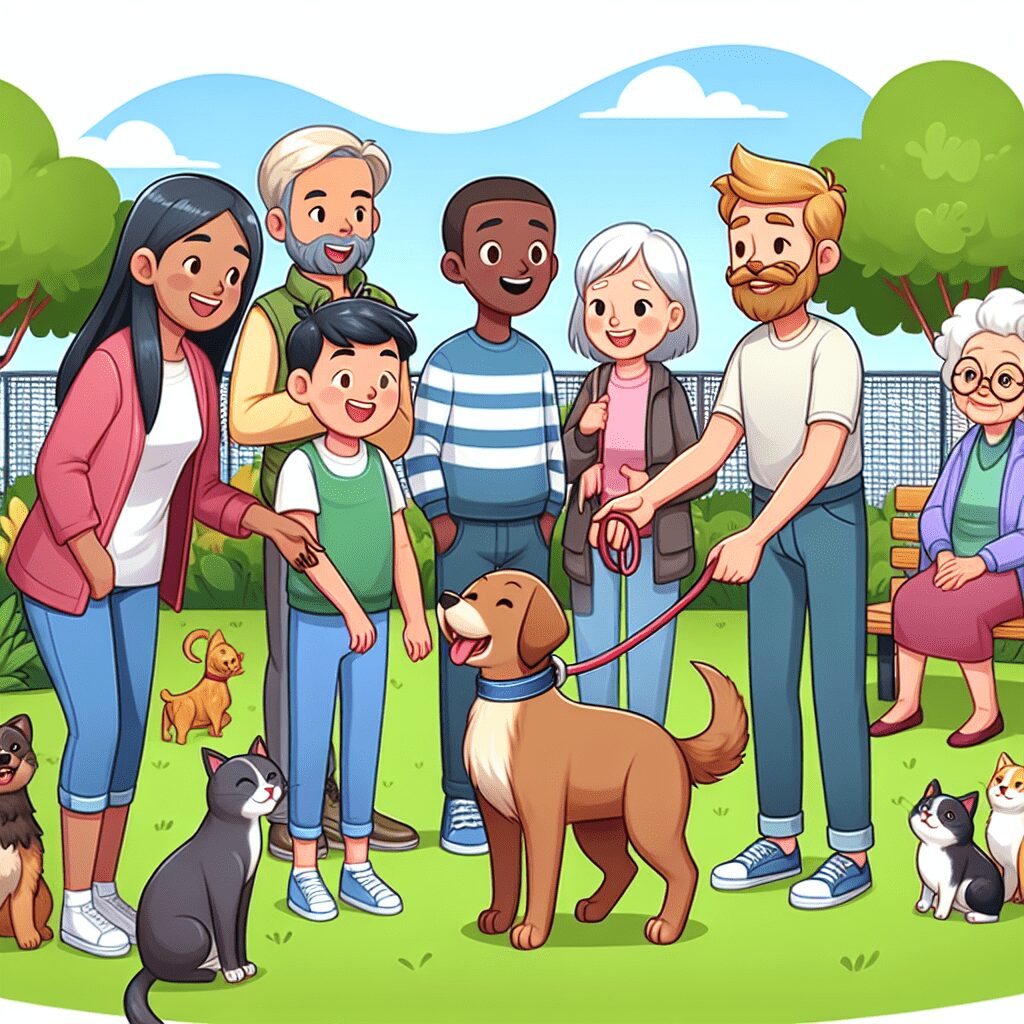Pawsitive Encounters: A Complete Guide to Socializing Your Dog with Pets and People
Ah, the joy of having a dog! Those wagging tails, slobbery kisses, and the undeniable bond we share with our four-legged companions make life infinitely better. But as much as we adore our furry friends, there is a responsibility that comes with pet ownership, particularly when it comes to their behavior and ease of socialization. This is especially crucial when introducing your dog to new environments, people, and other pets. In this guide, we’re embarking on a tail-wagging journey towards socializing your dog with pets and people effectively.
Chapter 1: Understanding Socialization and Its Importance
Socialization isn’t just about letting your dog meet other dogs or people; it’s a lifelong process that builds the foundation for your dog’s happiness and well-being. Proper socialization can influence your pet’s demeanor throughout their lives, shaping them into confident and well-mannered companions.
A well-socialized dog is less likely to develop behavioral problems such as aggression or extreme anxiety. Socialization helps diminish fear and unease. It’s important to start socializing your puppy during the critical development period, which typically occurs between 3 and 14 weeks of age. However, it’s never too late to start! Adult dogs can also learn to socialize with positive reinforcement.
Chapter 2: The Dos and Don’ts of Dog Socialization
Now that we understand the significance of socialization, let’s dive into the essential Dos and Don’ts:
-
Do Expose Gradually: Start slowly and expose your dog to various situations in a controlled manner. This might mean meeting new people at a distance and gradually reducing the space as your dog becomes comfortable.
-
Don’t Force Interactions: If your dog shows signs of fear or aggression, don’t force the interaction. Instead, step back and try again later or in a different environment.
-
Do Use Positive Reinforcement: Reward your dog with treats, praise, and playtime for good behavior during social encounters.
-
Don’t Rush the Process: Socialization is a gradual process. Be patient and embrace the journey alongside your dog.
-
Do Attend Training Classes: Group training classes can provide a safe and structured environment for your dog to learn social skills.
By adhering to these guidelines, you both can enjoy a rewarding experience and form a stronger bond.
Chapter 3: Socializing Your Puppy: The Critical Early Steps
When it comes to puppy socialization, the world is practically a playground! Exposing your puppy to various environments, surfaces, sounds, and experiences is crucial at this stage. Here’s how to make the most of this critical period:
-
Discovery Walks: Take your puppy on walks to different neighborhoods, parks, and busy areas. Let them experience different sights, sounds, and smells.
-
Playdates: Organize playdates with other vaccinated puppies. This provides an excellent opportunity for your puppy to learn social cues.
-
Vet Visits: Make the vet’s office a positive experience by letting your puppy meet staff members and other pets in a friendly manner. A happy experience can help eliminate future anxiety associated with visits.
-
Exposure to People: Introduce your puppy to various people—men, women, children, and those wearing hats or sunglasses—to help them learn to feel comfortable around diverse individuals.
Remember, the key is to keep these experiences positive and filled with joy to build confidence.
Chapter 4: Socializing Adult Dogs: Breaking Barriers
For adult dogs, socialization might be a bit more challenging but is entirely achievable with patience and consistency. Here are steps you can take:
-
Structured Meet and Greets: Arrange short, structured meet and greets with calm, well-behaved dogs. Doing this in a neutral location can ease any territorial instincts.
-
Desensitization: Gradually desensitize your dog by exposing them to their triggers at a distance. Slowly decrease the distance while rewarding calm behavior.
-
Use the “Look at That” Method: This technique involves having your dog look at a triggering stimulus (e.g., another dog) and then rewarding them for remaining calm. This approach creates positive associations with previously scary situations.
-
Encourage Exploration: Allow your dog to explore surroundings at their own pace without overwhelming them. Reward them for bravery and curiosity.
Be kind and understanding that some adult dogs may learn social skills differently compared to puppies. Celebrate their successes!
Chapter 5: The Power of Positive Reinforcement
Positive reinforcement is the golden ticket to socializing your dog effectively. This approach involves rewarding your dog for appropriate behavior, resulting in a happier and more energetic companion. Here’s how to implement it:
-
Use Treats: Carry tasty treats during socialization sessions to encourage your dog’s brave behavior.
-
Praise and Affection: Verbal praise and physical affection are essential. Show your dog that they’ve done well with an excited tone and a scratch behind the ears.
-
Playtime as a Reward: If your dog enjoys playing fetch or tug, use that as motivation. If they successfully meet someone new without reacting negatively, reward them with playtime!
-
Consistency Is Key: Be consistent about what behaviors receive rewards—this leads to clear expectations and quicker learning.
By consistently applying positive reinforcement, your dog will begin to associate socialization with good feelings, making encounters enjoyable.
Chapter 6: The Role of Enrichment in Socialization
Just like us, dogs thrive on stimulation, both mentally and physically. Engaging in enrichment activities helps dogs release pent-up energy and builds confident, well-rounded personalities. Inclusion of enrichment can greatly improve your dog’s social skills:
-
Interactive Toys: Toys that stimulate problem-solving and creativity keep your dog engaged and reinforce their positive experiences with new environments.
-
Scent Work: Engage your dog in scent games where they can explore various smells. This mentally stimulating activity helps dogs feel accomplished and confident.
-
Obstacle Courses: Build a simple obstacle course in your yard or home. This encourages confidence and agility as your dog navigates through different challenges.
-
Fetch and Tug: Instead of just basic walks, incorporate engaging activities with friends or family to promote healthy interactions.
Through enrichment, you can enhance your dog’s social interactions and help elevate their confidence.
Chapter 7: Overcoming Challenges in Socialization
Along the journey of socializing your dog, you may encounter challenges that require special attention. Luckily, there are strategies you can implement:
-
Fearful Behavior: If your dog shows signs of fear, invest time in desensitizing techniques and crate training as a safe space. Always approach fear-based triggers slowly and reward calmness.
-
Reactiveness: For reactive dogs, it helps to practice parallel walking with another dog while keeping a safe distance. Gradually decrease the distance while rewarding your pup.
-
Aggression: If you have an aggressive dog, consult a professional dog trainer or behaviorist. Mild cases could improve with training, while others may require specialized attention.
Remember that setbacks may happen, but progress is often not linear. Remain patient and compassionate as your dog navigates their path to confidence.
Chapter 8: Maintaining Social Skills and Lifelong Learning
The journey of socializing your dog doesn’t end after puppyhood or with a few training classes. It’s essential to maintain and reinforce their social skills throughout their entire life:
-
Regular Socialization: Continuously expose your dog to new people, pets, and environments. Regular outings help reinforce their learnings.
-
Continued Training: Engage in various training classes and group activities that encourage social interactions.
-
Community Events: Participating in community dog events, festivals, or park meetups helps reinforce your dog’s confidence and ability to socialize with others.
-
Bonding Time: Spend quality time with your dog to promote trust, relaxation, and happiness. A happy dog is often a confident dog!
By committing to continual social growth, you strengthen your bond with your dog while ensuring a harmonious life together.
Conclusion
Socializing your dog with people and other pets is a beautiful journey filled with learning, patience, and joy. As loving dog owners, it’s our mission to guide them through these experiences safely and happily. Embrace every moment, from a joyous meeting with other dogs at the park to snuggly moments on the couch after a successful outing. By using positive reinforcement and understanding your dog’s needs, you can turn your pup into a wonderfully well-adjusted companion. Explore together, learn to trust each other, and enjoy every paw-sitive encounter along the way.
FAQs
-
What is the best age to start socializing my puppy?
The best time to start socializing your puppy is between 3 and 14 weeks of age. This is the critical puppy socialization period. However, you can still socialize adult dogs.
-
Can my aggressive dog be socialized?
Yes, many aggressive dogs can be socialized with the appropriate training and guidance. It’s often advisable to consult with a professional trainer or behaviorist for tailored support.
-
What should I do if my dog shows fear during socialization?
If your dog displays fear, take a step back. Ensure they feel safe and try to gradually expose them to their triggers while rewarding calm behavior.
-
How often should I socialize my dog?
Aim to socialize your dog regularly, incorporating new people and experiences into your routine. Consistent exposure aids in maintaining their social skills.
-
Is it possible for socialization to be harmful to my dog?
While socialization is beneficial, overwhelming your dog can be counterproductive. Always approach new experiences at your dog’s pace and avoid forcing interactions.
-
What activities help with socialization?
Activities such as group training classes, playdates with other pets, discovery walks, and attending dog-friendly events promote excellent socialization opportunities.
-
How can I increase my dog’s confidence?
Engaging in enjoyable activities like scent work, interactive toys, and training exercises can help your dog become more confident and comfortable in social situations.
-
What role does positive reinforcement play in socialization?
Positive reinforcement builds a connection between good behavior and positive outcomes, encouraging your dog to embrace socialization through rewards and affection.
Unlock the Secrets to a Well-Behaved Dog! 🐾 Tired of your pup’s bad habits? Discover how to transform your unruly dog into a loving companion with our FREE Dog Training Mini Course! Learn essential commands, potty training tips, and effective techniques to eliminate unwanted behaviors in just days. Don’t miss out—sign up now and start your journey to a happier, obedient dog! Join Here! (https://bit.ly/3RJak0a)
Instantly Access Your Free Children’s Books Here! (https://payhip.com/BlueCherryStore) – Disclaimer: As an Amazon Associate, I earn from qualifying purchases, I may earn a commission from qualifying purchases as an affiliate. Please note that I only recommend products I believe will provide value to my readers. (M)









